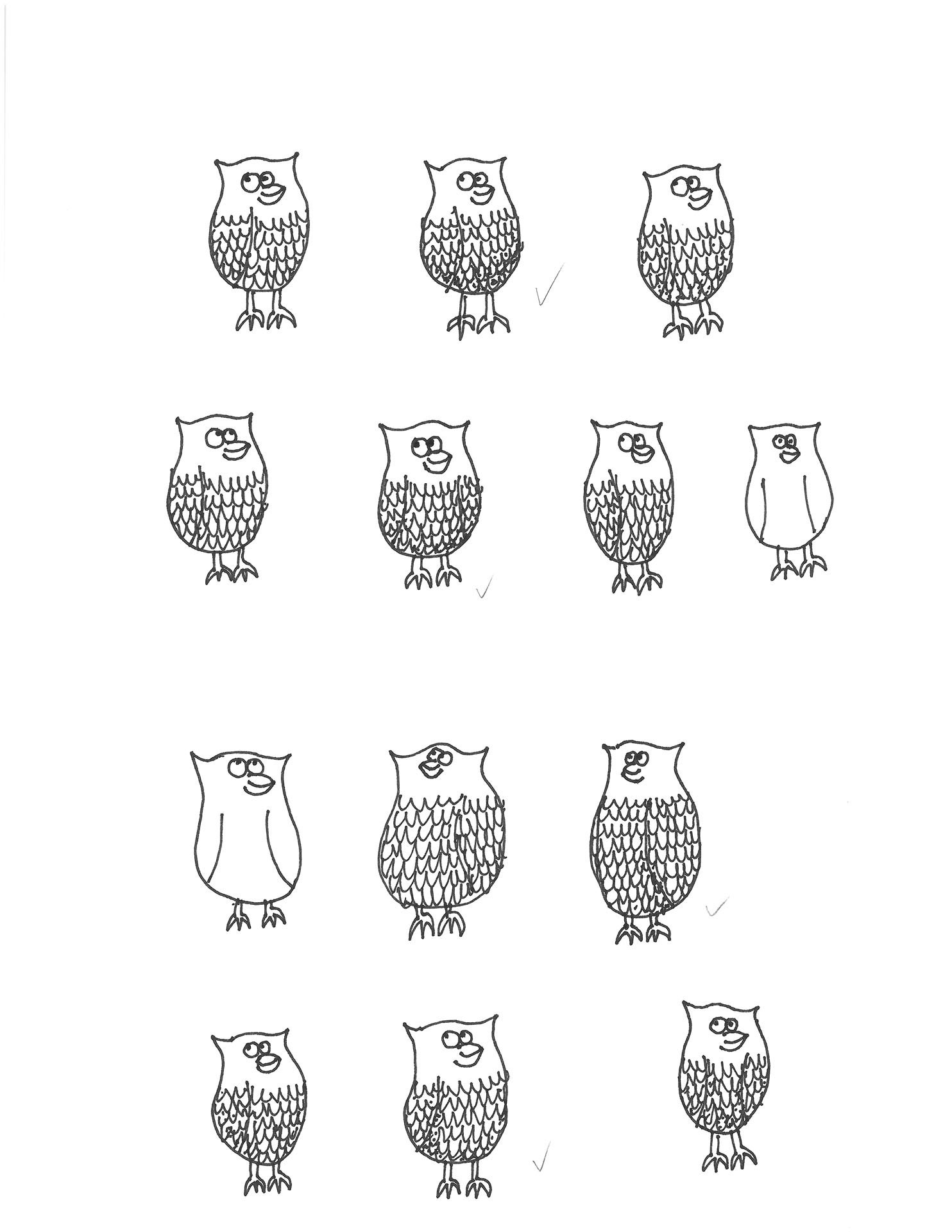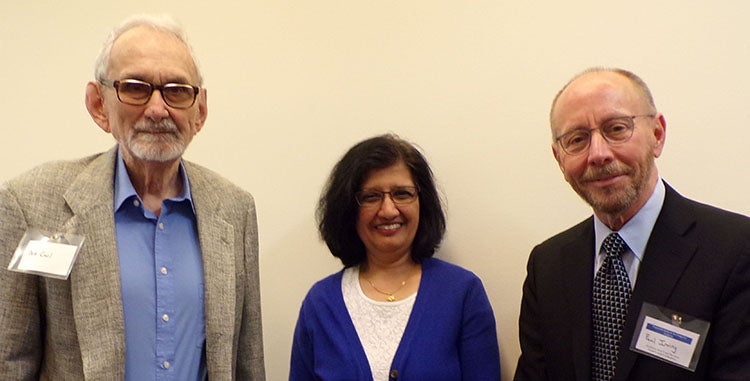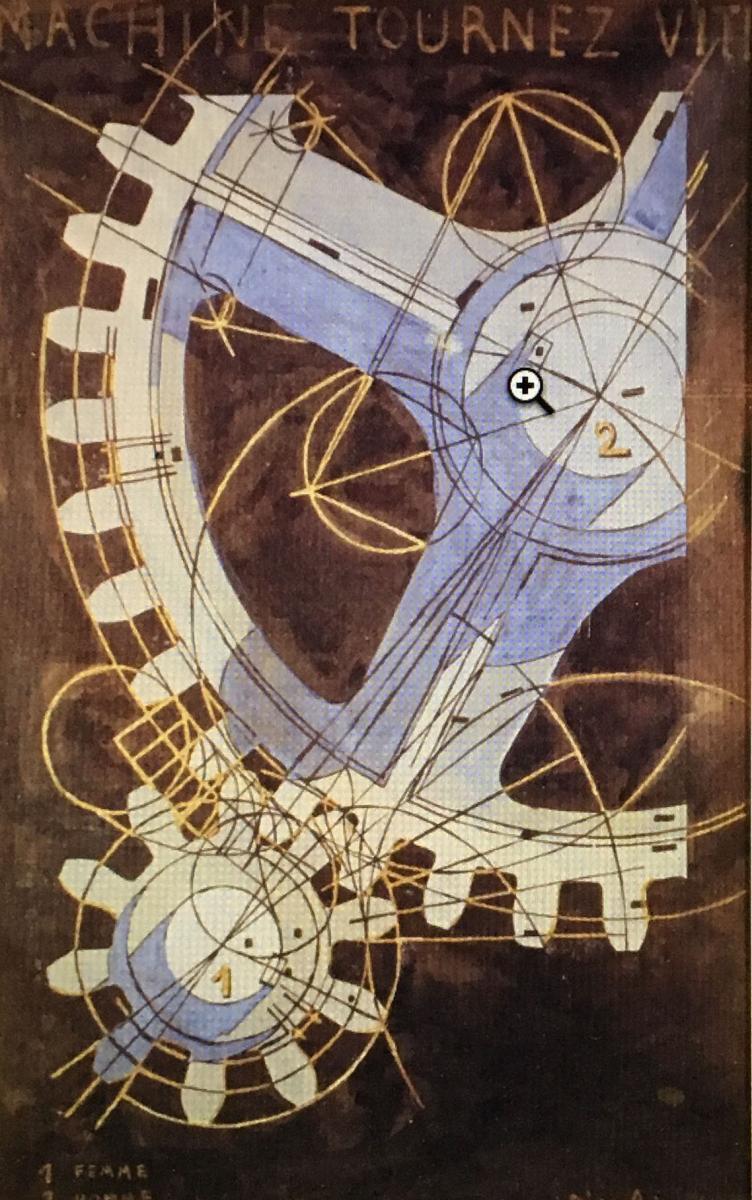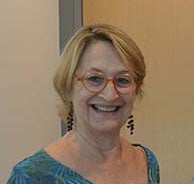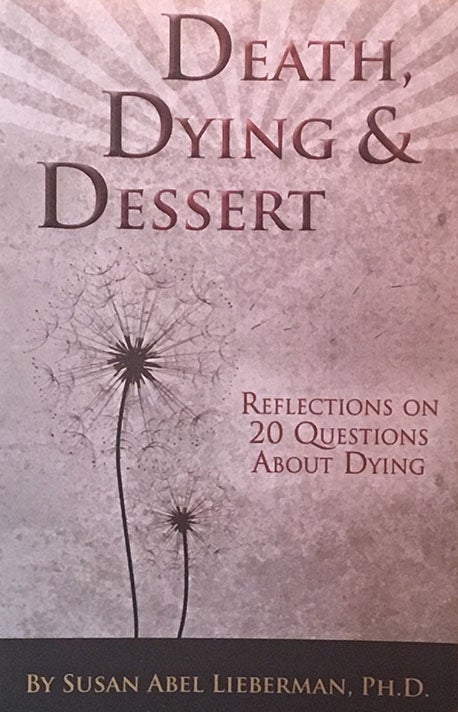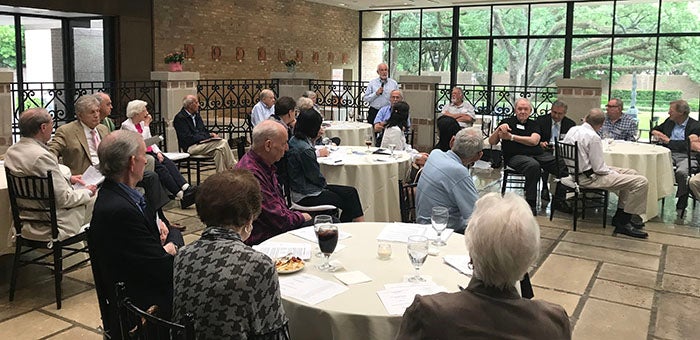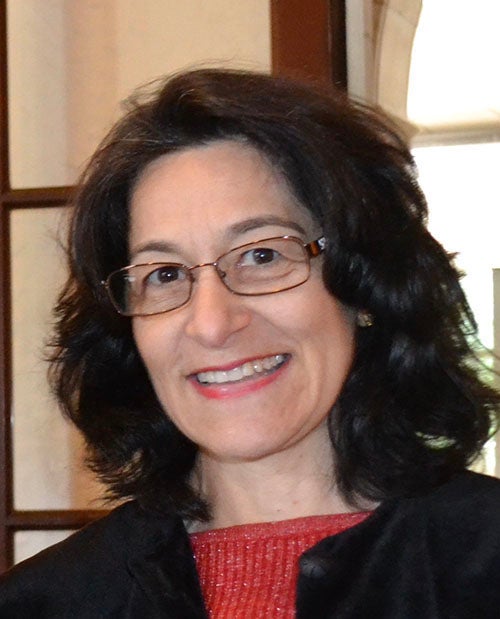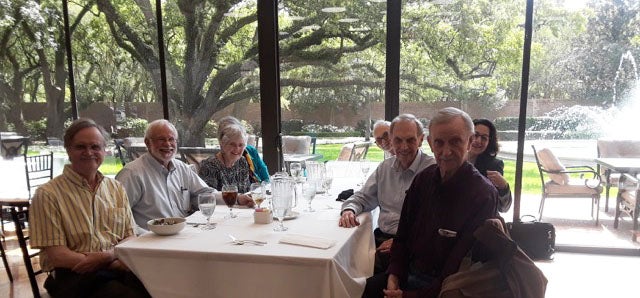LET'S GET RIGHT TO THE NEWS (Click on short titles or scroll down):
• The March 21st Conference on Purposeful Aging and the Longevity Economy
• ARRUF and the Innovation District
• The GrandArts Lecture April 17: Constructing the Ultimate Picabia Resource
• Memoir Group Reunion March 22
• Lieberman on Death, Dying, and Dessert
• Annual Meeting and Reception May 2
• Andrews on "The Shelf Life of Books"
• Members for the Membership Committee
Bob Curl, ARRUF Director; Rice Alumna Olina Raney, Ph.D.; and Speaker, Paul Irving, Chairman, the Milken Institute's Center for the Future of Aging
March 21 Conference on Purposeful Aging and the Longevity Economy Highlights
The March 21st Conference, Purposeful Aging and the Longevity Economy, was well attended not only by ARRUF members but by faculty and administrators across the Rice campus and by guests from the University of Houston Downtown and the community. The session was introduced by Professor Barbara Ostdiek, Associate Dean of the event’s co-sponsor, the Jesse H. Jones Graduate School of Business. She emphasized the relevance of the conference’s key terms, “purpose” and “longevity” for both institutions and individuals. The event was planned to increase understanding of the context for retired faculty organizations in the future, which is changing because of the rapid growth of the older popultion. Few participants realized that every day over 10,000 people in the U.S. turn 65. The large proportion of older adults will soon generate huge costs for society unless preventive and adaptive measures are taken, including lifestyle changes to improve health. Fortunately, research studies have already shown that certain practices can greatly reduce the incidence of such costly afflictions as dementia and Alzheimer's Disease. Irving pointed out that people with a positive attitude and a purpose also enjoy longer lives and greater satisfaction. Download his PPT.
A panel led by former dean of engineering C. Sidney Burrus commented on the applications of Irving's talk for retired faculty. Panelist Tom Killian, Professor in the Department of Physics and Space Physics, and Rice University's representative to the consortium of universities involved in the new Houston Innovation District, talked about how fledgling companies could benefit from having retired faculty mentors and advisors. Mark Kulstad, Professor Emeritus from Philosophy and currently the Academic Director in advanced degree programs in the Suzanne M. Glasscock School of Continuing Studies, emphasized opportunities for continued teaching as well as the innovation district programs. Jackie Torres, who will soon receiver her Ph.D. in Psychological Sciences, has been studying workers' satisfaction over the lifespan, and she foresees value in lder workers' contributions in a longevity economy. Stephen Klineberg, Professor Emeritus and Founding Director of the Kinder Institute for Urban Research a tRIce, explained the different impacts aging may have in Houston's several ethnic communities. During lunch, participants took up the ideas presented by the speaker and panelists in a lively discussion lasting until after 1 p.m. More conference photos follow.
Review Conference Photos:
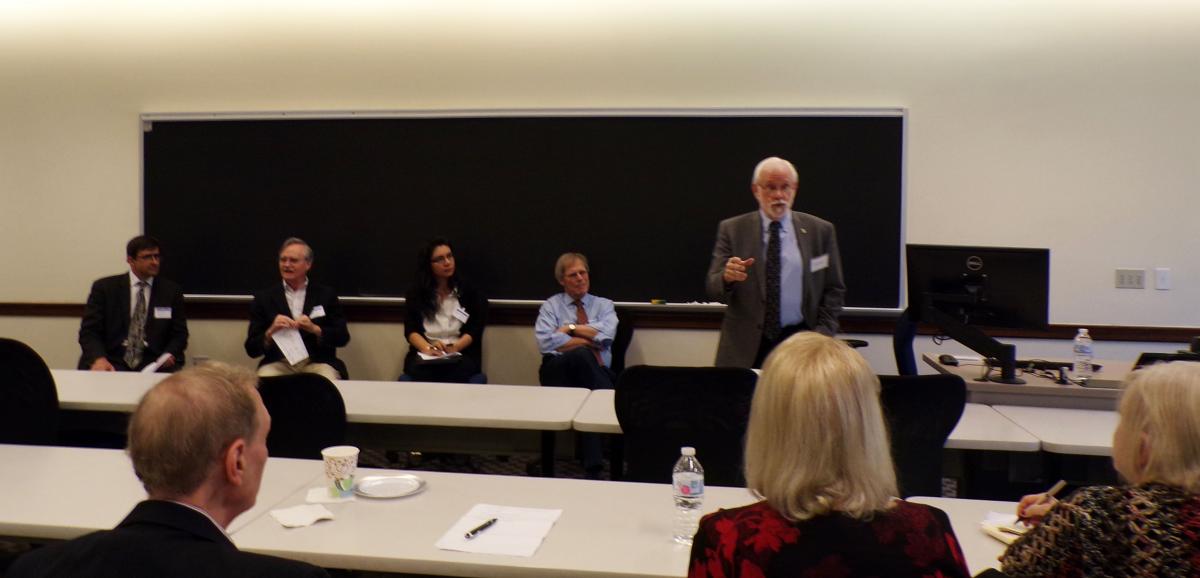
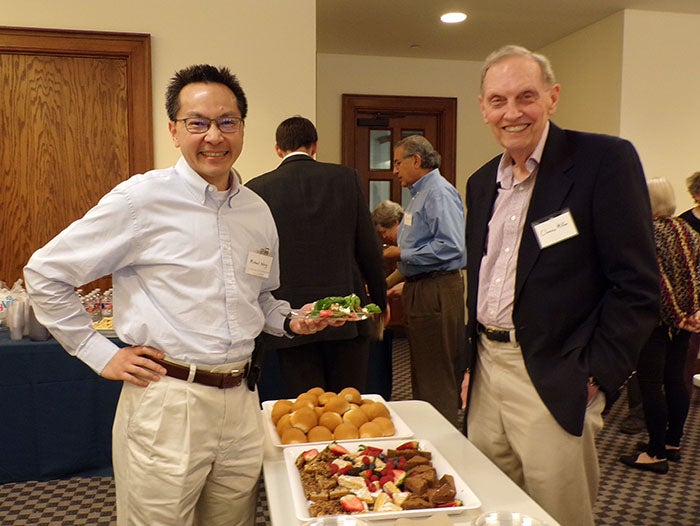

Susanne M. Glasscock School of Continuing Studies, and Jackie Torres, Ph.D. candidate
and specialist in workplace satisfaction across the lifecycle.
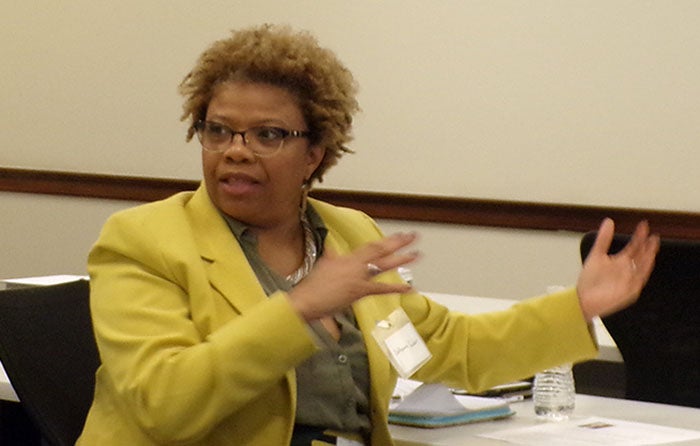
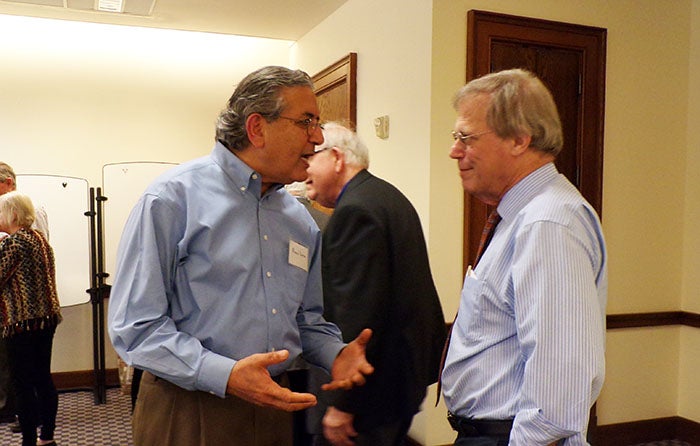
Be sure to invite your colleagues to attend next fall's half-day conference on technologies and aging!
Mentoring Change with the Innovation Hub
Addressing discrimination, gender inequality, and other challenges in Houston and creating pathways to opportunity.
Many people have been interested in finding out what will happen to “the old Sears building on Main Street,” which the Rice Management Company has purchased. The inspiring news is that the building will become “The Ion,” the anchor building in the new Midtown Innovation District, an area of over 13 acres that will bring together colleges and universities, corporations, the City of Houston, and not-for-profit organizations to foster economic growth and new business ventures. ARRUF is working with Professor Tom Killian of the Department of Physics, who is Rice’s representative to the Innovation Hub Academic Partnership Network, the group planning the future for the Innovation District. ARRUF members may have the opportunity to choose to volunteer as advisors to community teams hoping to start new businesses. Indeed, they can volunteer now by going to the website of Station Houston, which will manage the start-up activities in The Ion and is already acting as the guide for 200 companies. Chevron is currently providing two floors of office space to Station Houston at 1301 Fannin.
On Wednesday, March 6, an ARRUF team visited Station Houston's current offices. In the photo below, taken during the visit, you will recognize those who represented ARRUF (l to r): Sidney Burrus, Davd McStravick, Mark Kulstad, Ahmad Durrani, Bob Curl, and Clarence Miller. Mallik Putcha (on the far right) represented the retired engineers of NASA and the contractors related to NASA. It was the second meeting with Station Houston. The first was held a few weeks earlier at the Rice Faculty Club with Tom Killian (Rice's point person on the Partnership Network) and the CEO of Station Houston, Gabriella Rowe, shown standing in the photo with Hira Qarni (on right) and her colleague..
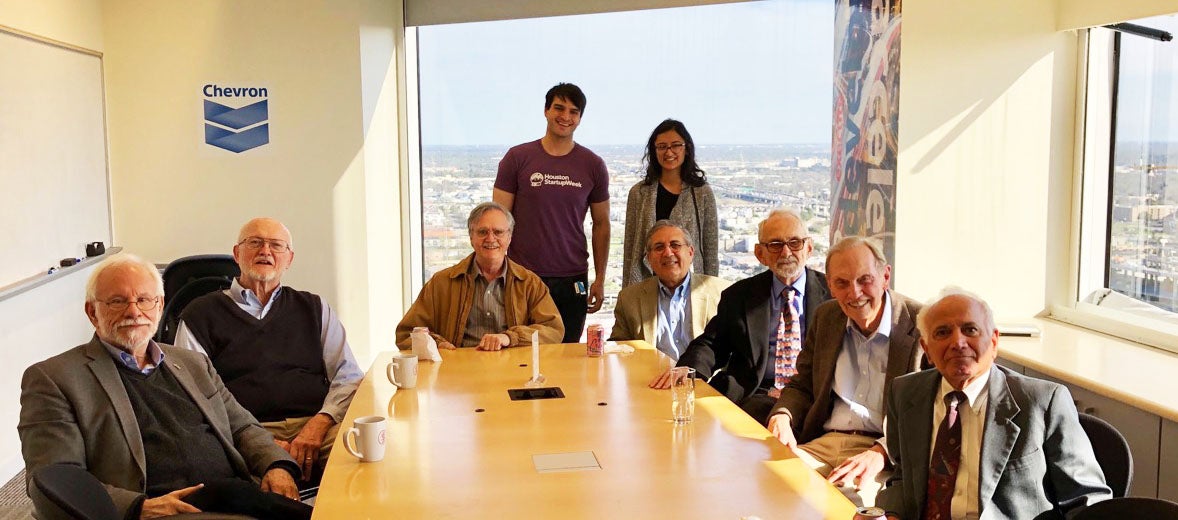
And now for something completely different that is coming up soon (April 17) . . .
education, fair use http://cgfa.sunsite.dk/p/p-picabia4.htm
The ARRUF 2019 Grand Arts Lecture: April 17, 3 p.m. The Double Studio at the Moody Center.
Constructing the Ultimate Picabia Resource: The Four-Volume Francis Picabia Catalogue Raisonné
William Camfield, Rice University, and Candace Clements, independent art historian
In some research fields, the adventure involves the enormous or the invisibly small: going to the moon or confirming the existence of the Higgs boson. Art historical scholarship might be said to exemplify that entire range. ARRUF member and Rice University professor emeritus William Camfield and independent scholar Candace Clements are two members of the Comité Picabia, which has locations in Houston and Paris. The Comité is nearing completion of a four-volume catalogue published in both English and French of the works of French artist Francis Picabia (1879-1953). On April 17th, they will provide a glimpse into that project and show some of Picabia’s paintings, drawings and other work. A reception in celebration will follow.
Members are asked to invite friends to this event. You may know others who are interested in the process of producing a catalogue raisonné or in Francis Picabia and the various styles he used. Please reply to ARRUF.invites@rice.edu to let us know you and your guests plan to attend.
Picabia was born in Paris into a wealthy French-Spanish family. He entered art school around 1900, and his style evolved through phases of Impressionism, Fauvism, Cubism, abstract art, Dadaist art, striking varieties of figurative art, and abstraction again in the late 1940s. He also produced a variety of texts, including Dadaist comments and poems, and a film (Entr’acte). In its nearly three decades of existence, the Comité has amassed a database of his art works that comprises around 4,000 entries, mostly paintings and drawings.
The artist’s widow, Olga Picabia, now deceased, established the Comité in the 1990s, enlisting the French-American couple Pierre and Beverley Calté and Rice University's Bill Camfield, and later Maria Lluïsa Borràs (now deceased). It has grown to include art historians Arnauld Pierre (Paris Sorbonne), Candace Clements (independent scholar), and Aurélie Verdier (Centre Georges Pompidou, Paris), who all participate, in varying degrees, in the preparation of each volume. The Comité meets twice a year in Picabia’s first and final home, atop a building in the heart of Paris, and they communicate constantly throughout the year.
Ideally a catalogue raisonné documents and illustrates the entire body of an artist’s work; each work is examined physically (unless lost or inaccessible), photographed, and documented in terms of material, dimensions, inscriptions, physical condition, history of ownership, and record of exhibitions and publications. The Picabia catalogue presents each work with its factual information and sometimes a brief commentary. Each volume also has a major text that addresses the history of the period in question, with shorter essays on more focused topics, making it an art book as well as a catalogue. A published catalogue raisonné presumably authenticates all of the works illustrated and is a valuable resource for museums, auction houses, art dealers and collectors.
Mr. Camfield and Ms. Clements will talk about the process involved in verifying each artwork, the risks posed in publishing a catalogue, and the rewards of this extensive journey.
To help us plan for the reception, kindly reply to ARRUF.invites@rice.edu


Bird Walk Winged Wonders
On Sunday, March 10th, ARRUF bird expert Mark Kulstad led a field walk to spot legendary birds now passing through Texas and Houston in particular. The group was able to see several species resting and avoiding the strong winds that were whistling south. Big, showy birds stop off here, including American White Pelicans, both species of Texas cormorants, wintering ducks of multiple species, the occasional Roseate Spoonbill and Black-crowned Night-Heron, Great Blue Heron, Great Egret, Snowy Egret, White Ibis, raptors, and more. Over 200 species of birds have been recorded around Archbishop Fiorenza ParkPhase II (west of Eldridge Rd.) and Brays Bayou Park, plus lots of interesting small birds. This park--the trip site--the area near Westpark and Hwy 6, is a new parkland in Houston associated with other flood prevention retention basins.
Joining Mark were Hiroko and Randy Singh, Hilary and Clarence Miller, and Viqui Arbizu-Sabater. As the photos show, the cool breezes weren’t bothering them. An impromptu lunch at a local spot finished the trip.
We hope to have an ARRUF event in mid-winter 2019 when the bird migrations are at a peak, near the famed Annual Bird Count on New Year’s Day. You might mark your calendar now to watch for more information.
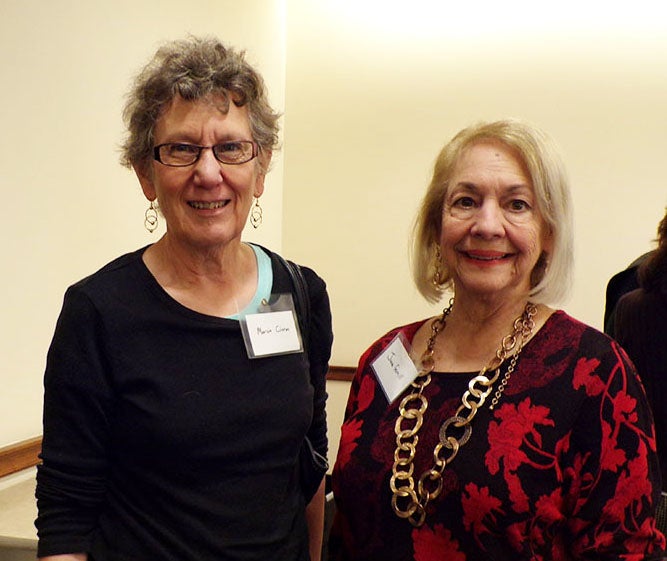
Memoir Writers Gathered on March 22
March 22 was reunion time for the Memoir Writers Group. June Ferrill, the group’s leader, came in from Santa Fe, NM to attend the Conference on Purposeful Aging and the Longevity Economy, then stayed overnight to lead the group in a discussion of their academic memoirs. Marcia Citron, shown with June at the Conference, read aloud a passage on returning to Berlin to seek original materials on Fanny Mendelsohn and encountering the heavily armed troops at Checkpoint Charlie and beyond. Dave Schneider added an episode from his much longer work– this one on graduate school in psychology at Stanford. June shared an example of capturing childlike thinking in age-appropriate prose style from her own autobiography, which begins with the startling declaration in an eight-year-old’s voice: “’I need that gun on the ranch,’ I shouted at Fat Marsha.” June’s skillful evocation of childhood misperceptions is the basis of a revealing chapter (P.S. the silver-plated, pearl-handled “gun” in question is a cap pistol, but a real necessity in the child’s imagination for life where the family is moving.)
Even if you’ve never drafted a memory in a file, you can come sit in on sessions until you’re ready to focus your own remembrances. The next meeting will be Friday, April 26th, at 10 a.m. in Fondren 412. Come with or without a draft and share a cup of coffee and intriguing insights into others’ experiences. June would be glad to know you’re thinking of attending. Let us know with an e-mail to ARRUF.invites@gmail.com
Thad Logan on How We Speak Well of Each Other: Eulogies, Tributes, Birthday Poems, and other Encomia
On Feb. 12, 2019, English Department retired scholar Thad Logan brought to ARRUF her deep understanding of a genre central to human cultures: the praise of others. Famous in Greek as the epitaphios logos and in Latin as the laudatio funebris,economia predominantly praise heroes, often at funerals. But praise goes beyond funerals and memorials. It can be found in many branches of rhetoric: judicial, deliberative, epideictic (praise or blame) and in multiple modes: logos, pathos, ethos. Thad showed the group assembled in Fondren 412 a modern classic, Maya Angelou’s eulogy for Coretta Scott King, available on YouTube, which you could watch: https://www.youtube.com/watch?time_continue=446&v=otGXTrye And to represent an ancient classic, she provided excerpts from Pericles’ Funeral Oration in Thucydides’ History of the Peloponnesian War, c. 430 BCE, also available through your browser at https://sourcebooks.fordham.edu/ancient/pericles-funeralspeech.asp
Thad pulled examples from many centuries and our own era over the course of the session. For those of us buffeted by overuse of “amazing,” “first class,” and “wow,” her talk reminded us of the power of language to express esteem for the brave and honorable among us.
Susan Lieberman Lifted Valentine Hearts with Death, Dying, and Dessert
A bit before Valentine’s Day, a group gathered in Fondren 412 around the conference table decked with a pink tablecloth and multiple desserts–cheesecake, cookies, candies, strawberries, and more–to discuss with ARRUF colleague Susan Lieberman her slim volume, Death, Dying, and Dessert. The book covers all the ways you can make your own passing easier for your loved ones and in line with your own final wishes. There are extra copies, courtesy of Susan’s publisher, for those of us who didn’t make the session but still need to have a frank discussion with our families. “The talk” can’t be easy, but it can be deeply satisfying for all. Check the bookshelf in 412 to pick up your free copy (while supply lasts).
Last Year's Annual Meeting
Ahead: The Annual Meeting and Reception for New Retired Faculty
Don’t wait. Click now on your calendar or march to the hall with a pen to write in the ARRUF Annual Meeting and Reception for New Retired Faculty: May 2, at the Faculty Club at 3 p.m. Read the annual report to be delivered via e-mail and on the website later in April so the discussion at the annual meeting can be BRIEF and the celebration can begin early!
Ahead: Director Viqui Arbizu-Sabater Becomes ARRUF Ambassador, Will Reside in Spain
ARRUF Director Viqui Arbizu-Sabater has served with enthusiasm and insight since her election to the Board in May 2018. A strong advocate of U.S. Friends of International Students at Rice, she worked with Dr. Adria Baker of the Office of International Students and Scholars to encourage ARRUF members to participate in training for becoming advisers and friends. A growing group of people is coming from other countries to study at Rice; U.S. friends can be vital to their success. The photos show the pleasure and warmth that the relationships foster.
Now Viqui and her husband are returning to Spain, where they will live in Seville. Although she will relinquish her elected position as a director of ARRUF, the ARRUF executive committee has appointed her as an ARRUF Ambassador. Viqui plans to approach colleagues at the University of Seville to host an event for retired faculty and ARRUF visitors next summer in 2020. Viqui’s energy and effectiveness have been remarkable as a member and leader of ARRUF. In fall 2018 she hosted a five-week series of conversations in Spanish about contemporary issues in Fondren 412, assisted by Dr. Maria Teresa Rocha from the Institute of Hispanic Culture of Houston, Teresa Treviño, one of the co-founders of Casa de Expana in Houston, and from LAGSA at Rice, the international graduate students Samantha Samaniego and Samuel Castro.
We appreciate the Provost’s appointing her to the Steering Committee that guided the organization’s start-up period, and this past year she has served as an ARRUF elected director. Everyone will miss her, but with ZOOM videoconferencing, we may be able to continue to benefit from her participation. Put a note on your 2020 planning sheet to be ready to travel with ARRUF to Seville next year.
ARRUF will celebrate Dr. Arbizu-Sabater's service at the April Faculty Club Lunch on April 11. Be sure to attend!

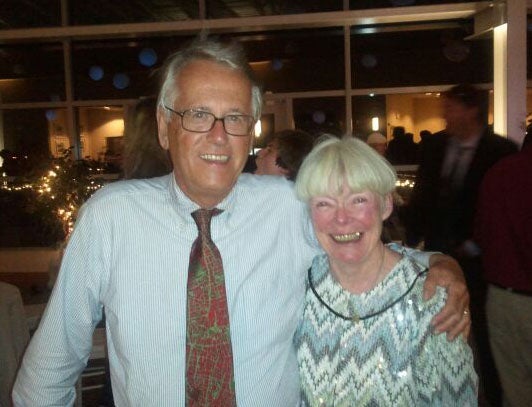
A Retired University of Delaware Professor Reflects: “The Shelf Life of Books”
ARRUF has chosen the transport of faculty members’ excess books to the Rotary International “Books for the World Project” as a service to ARRUF members. Giving up the books that have been central to our professional lives can be wrenching; what we oftentimes pay storage companies, literally, is the price for our resistance. [In June we will trade our non-professional “beach reading” books (the mysteries and thrillers) at the ARRUF Book Swap.]
Now retired professor Deborah C. Andrews from the University of Delaware has written a piece about how she and her husband William Andrew (a novelist and former college president) took the challenge head on as they “moved house” to a charming but small ground-floor pied-a-terre north of Portland, Maine. The essay, The Shelf Life of Books,is reprinted here with her permission. Be inspired as you assemble your own books for ARRUF’s May transport to benefit others across the world for whom their “shelf life” is still good. [You may download a copy of this essay here.]
The Shelf Life of Books
Deborah C. Andrews, Professor Emerita, University of Delaware
After I retired from the English department at University of Delaware, I moved back to Maine with two boxes of books selected from those I had in my office. Those books joined others in my study at home in the mountains and in a small condo in Portland, where we had built ample shelves for our collection. When we sold the condo last year, we bought another, but it had no bookcases. We moved our Portland library, in 35 heavy boxes, into what would become a study in our new condo, and promised ourselves that we would reduce their number at leisure but with rigor. We took the lack of bookcases as an incentive.
Our job fell neatly into the currently fashionable trend toward tidying advocated by Marie Kondo. While the KonMarimethod seems to apply mostly to clothes, shoes, and household goods, it is easy to make it fit books. Books lend themselves to making piles; they are inherently both folded and upright for placement in containers; they can be grouped by size and thrive in categories.
Over the years, books have served our joint academic careers and provided abundant pleasures for us as readers of other people’s writing and as writers. But we had to decide, to shift the metaphor, the shelf life, on the very limited shelves of a few new bookcases, of each book in the boxes. Items like food or medicines have expiration dates beyond which they are no longer suitable or safe, requiring merchants to remove them from their shelves. Books can expire, too, if they are, say, eaten by mice, moldy or mildewed, damaged by water, or faded by exposure to light. But unlike food or medicine, the books in our 35 boxes were still safe for display and safe for handling and reading—by someone.
From our days in graduate school, where we met, married, and created bookcases with bricks and boards, books have been a major part of our physical environment as well as central to our intellectual and career pursuits. We’ve designed rooms around bookcases, and books, wherever we’ve lived. They are key objects of our identity. You can know a lot about us by reading our bookshelves. We had fun, for example, placing The Joy of Cooking next to The Joy of Sex on the bookshelf in our kitchen. When we’ve gone to parties at other people’s homes, we’ve indulged in a kind of voyeurism as we’ve read their shelves for insights into their private worlds made evident in this seemingly public display. So one big criterion for keeping a book was how much of us was invested in it or, in Kondo’s terms, whether it “sparked joy.” My husband, for example, once a scholar and teacher of colonial American literature and culture, decided he wanted to keep the paperbacks and hardbacks he had accumulated in that pursuit. These items had remained mostly closed for the 20 years we were in the Portland condo. But he had been immersed in their silent presence then, and he wanted to keep that aura, even as his career took off on a very different path. Unboxing and shelving books like The Selected Letters of Cotton Mather has inspired him to read some of them again, including, now, a lengthy biography of Mather.
We also kept books that had special value because they were rare, like first editions of novels and expensive art books and exhibit catalogues, especially those signed by the artists. We also kept groups of contemporary books centered on historic events of our interest, like the 1876 Centennial and World’s Columbian exhibitions. We devoted a new credenza, with tall shelves, for such books in the living room.
Once objects devoted to colonial America had emerged and been placed on the shelves, we unboxed other books of the American literary past, up through Thoreau, Emerson, Twain, James, and Howells, and we continued shelving. There were many duplicates, especially at the point chronologically where my brief excursion into the scholarship of American literature had begun. There were also discoveries. As we opened books, we sometimes found notes or old bookmarks that reminded us about how far we had read at some point in the past. Several books had our names in them, some with just my name, handwritten, or my husband’s, or some stamped with our then newly joined names. Many books were underlined or otherwise bore the imprint of us as readers and teachers of the item. We’d linger a bit over those. Most books on architecture and material culture are housed in my study at home because I came back to them, and to my passion for those matters inspired by my graduate work in American Civilization, late in my career at Delaware. When we rediscovered a few books in that category, we set them aside. Sometime a signature on a gift book made us think of a friend or family member, and we designated that a keeper. Sometimes a book overlooked for years took on new relevance in today’s political or intellectual context and we felt it warranted shelf space and re-reading. We selected out books we thought might interest friends and created a pile of those, to be mailed to them. We devoted one of our now-empty boxes to Southern US literature and history; the box awaits the visit of a colleague who specializes in such matters.
But the more we worked through the piles of books on the floor, the more we realized: no, we don’t need it now. We realized we don’t need anthologies, most literary criticism, popular social history, a lot of urban planning, folklore studies (once a focus of mine. Done). We seriously considered how many copies of textbooks we had written, some jointly and some just mine, we needed and pared down to a couple of each.
It became easier and easier to discard books, especially once we had designated empty boxes for them. In the end, we created four such boxes, which we brought to our local Goodwill store. We began to feel better, too, as we thought about the readers who could enjoy books that had given us pleasure but, we realized, were unlikely to do so again. Their shelf life had expired for us. But they themselves had not expired. We now look forward to rediscovering the delights of books forgotten but newly attractive. We also like how the new matching bookcases look. There’s less shelf space than in the ones we left behind, but they hold a newly enlivened selection of books. To cite the title of an Anthony Powell novel, books do furnish a room. And our lives.
ARRUF Lunch Tables at the Faculty Club - Second Thursday in the Month, April 11
The reserved tables are sometimes on the terrace, sometimes down in the dining room, so ask the person when you check in at the Faculty Club where the ARRUF reserved tables are located. Go through the buffet and choose your feast, then head for the ARRUF tables. You will be welcomed with smiles and good conversation. You pay for your own lunch, but the collegiality is FREE. We will honor Viqui Arbizu this month. Members shown at a Dining Room table in March.
Responsible, Thoughtful, Inspired, So Needed: Members for the Membership Committee
Deciding to be an active organization participant is pretty much a matter of feeling wanted, needed, and appreciated. We need members for a strong Membership Committee to ensure all members experience the benefits of being welcomed and part of a stimulating university community. The Membership Committee is the group standing in front of that metaphorical cliff over which so many retirees almost declare they fall when they turn in their keys and march out the door. The Membership Committee makes sure new retired faculty have information about how to prevent their computer account from being deleted, a cup of coffee and conversation in Fondren 412, a personal welcome to ARRUF, and affirmation that new collegial friendships can span formerly unbridged distances between disciplines and schools. It’s inspiring to find out how much humanists, scientists, musicians, engineers, and social scientists have in common. ARRUF needs people who will look out for their fellows, alert the Benefits and Privileges Committee if new members are experiencing problems, and extend the warmth that all of us have known at ARRUF meetings, receptions, and events. If you haven’t joined an ARRUF committee yet, PLEASE CONSIDER THE MEMBERSHIP COMMITTEE. Help us build the University-wide community that will strengthen Rice for the future.
The Committees Calendar
Activities Committee: Tuesday, April 9
Budget Committee: Wednesday, April 10
Executive Committee: Thursday, April 11
Membership Committee: will meet in May, TBA.

